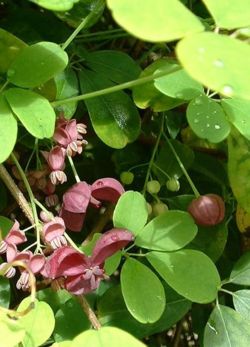Akebia
| Akebia subsp. var. | Chocolate vine | |||||||||||||||||||||||||||||||||||||||||||||||||||||||
|---|---|---|---|---|---|---|---|---|---|---|---|---|---|---|---|---|---|---|---|---|---|---|---|---|---|---|---|---|---|---|---|---|---|---|---|---|---|---|---|---|---|---|---|---|---|---|---|---|---|---|---|---|---|---|---|---|

|
|
| ||||||||||||||||||||||||||||||||||||||||||||||||||||||
| ||||||||||||||||||||||||||||||||||||||||||||||||||||||||
| Standard Cyclopedia of Horticulture |
|---|
|
Akebia (from Akebi, its Japanese name). Lardizabalaceae; by some included in Berberidaceae. Twining woody plants. Glabrous twining shrubs: Ivs. half-evergreen, long-petioled, digitate: fls. monoecious, in axillary raceme, the pistillate at the base, the staminate smaller, at the end of the raceme; sepals 3; stamens 6; carpels 3—12, with sessile stigma: fr. a large oblong berry with numerous seeds imbedded in a pulp, opening along the inner suture. — Two species with several varieties in Japan and China. The akebias are very ornamental, hardy climbing shrubs of graceful appearance, especially adapted for places in which very dense shade is not wanted. They require a sunny position and well-drained soil; also valuable in the cool greenhouse for covering pillars and walls, growing best in a sandy compost of loam, leaf soil and peat. In Japan, the fruit which is very showy but with us rarely produced, is eaten, and the stems are much used for wicker-work. Propagation is by seeds, by greenwood or hardwood cuttings, and also by root-division and layers.
|
| Akebia {{{status}}} Fossil range: {{{fossil_range}}}
| ||||||||||||||||||||||||||||||||||||||||||||||||||||||||||||||||||
|---|---|---|---|---|---|---|---|---|---|---|---|---|---|---|---|---|---|---|---|---|---|---|---|---|---|---|---|---|---|---|---|---|---|---|---|---|---|---|---|---|---|---|---|---|---|---|---|---|---|---|---|---|---|---|---|---|---|---|---|---|---|---|---|---|---|---|
 Akebia quinata | ||||||||||||||||||||||||||||||||||||||||||||||||||||||||||||||||||
| Plant Info | ||||||||||||||||||||||||||||||||||||||||||||||||||||||||||||||||||
| ||||||||||||||||||||||||||||||||||||||||||||||||||||||||||||||||||
| Scientific classification | ||||||||||||||||||||||||||||||||||||||||||||||||||||||||||||||||||
| ||||||||||||||||||||||||||||||||||||||||||||||||||||||||||||||||||
| [[{{{diversity_link}}}|Diversity]] | ||||||||||||||||||||||||||||||||||||||||||||||||||||||||||||||||||
| {{{diversity}}} | ||||||||||||||||||||||||||||||||||||||||||||||||||||||||||||||||||
| Binomial name | ||||||||||||||||||||||||||||||||||||||||||||||||||||||||||||||||||
| {{{binomial}}} | ||||||||||||||||||||||||||||||||||||||||||||||||||||||||||||||||||
| Trinomial name | ||||||||||||||||||||||||||||||||||||||||||||||||||||||||||||||||||
| {{{trinomial}}} | ||||||||||||||||||||||||||||||||||||||||||||||||||||||||||||||||||
| Type Species | ||||||||||||||||||||||||||||||||||||||||||||||||||||||||||||||||||
| {{{type_species}}} | ||||||||||||||||||||||||||||||||||||||||||||||||||||||||||||||||||
| Species | ||||||||||||||||||||||||||||||||||||||||||||||||||||||||||||||||||
| See text. | ||||||||||||||||||||||||||||||||||||||||||||||||||||||||||||||||||
| [[Image:{{{range_map}}}|{{{range_map_width}}}|]] | ||||||||||||||||||||||||||||||||||||||||||||||||||||||||||||||||||
| Synonyms | ||||||||||||||||||||||||||||||||||||||||||||||||||||||||||||||||||
| {{{synonyms}}} |
Akebia is a genus of just two species of flowering plant, within the family Lardizabalaceae. The scientific name, akebia, is a Latinization of the Japanese name for the genus, akebi. They are commonly referred to as chocolate vine, and are grown by gardeners as ornamental trailing vines. The purple or reddish purple flowers are borne on racemes and have a slight chocolate scent. Their fruits are edible. The two species have been cultivated into several varieties.
- Akebia quinata (Houtt.) Decne. : five-leaf akebia
- Akebia trifoliata (Thunb.) Koidz. : three-leaf akebia
- Akebia trifoliata subsp. australis (Diels) T. Shimizu
- Akebia trifoliata subsp. longisepala H. N. Qin
- Akebia trifoliata subsp. trifoliata